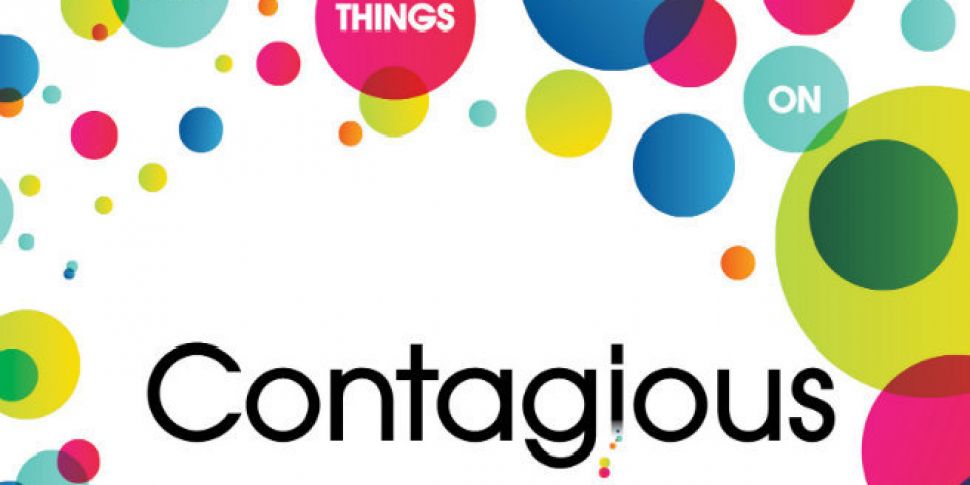Listen back to Alan Jordan and Ian Guider discuss the book on Newstalk Breakfast via the player above
Professor Jonah Berger was inspired by Malcolm Gladwell's "Tipping Point". He has been curious about what motivates people to share information and has made it his primary focus since that time. Chip Heath author of "Made to Stick", was Berger's mentor in graduate school. Berger is currently a Marketing Professor at University of Pennsylvania's Wharton School of Business specialising in viral marketing. This guy’s mission in life is to understand why messages go viral.
What makes things popular?
Berger says, “If you said advertising, think again. People don’t listen to advertisements, they listen to their peers. But why do people talk about certain products and ideas more than others? Why are some stories and rumours more infectious? And what makes online content go viral?”
Contagious tries to explain why and how to leverage these concepts to craft contagious content. This book sets out to provide a set of specific, actionable techniques for helping information spread—for designing messages, advertisements, and information that people will share. Contagious tries to show you how to make your product or idea catch on.
Harvard neuroscientists Jason Mitchell and Diana Tamir found that disclosing information about the self is intrinsically rewarding So talking about what you did this weekend might feel just as good as taking a delicious bite of double chocolate cake.
In The Tipping Point, for example, Malcolm Gladwell argues that social epidemics are driven “by the efforts of a handful of exceptional people” whom he calls mavens, connectors, and salesmen. Others suggest that “one in 10 Americans tells the other nine how to vote, where to eat, and what to buy.
How do you get others to like and re-share your stuff (idea, product, etc.) with their friends and colleagues? Jonah Berger provides a framework of six "features", or STEPPS which help explain why some messages "catch on":
1. Social currency: We share things that make us look good.
Does talking about your product or idea make people look good?
Can you find the inner remarkability?
Leverage game mechanics?
Make people feel like insiders?
Every day Berger says “the average American engages in more than sixteen word-of-mouth episodes, separate conversations where they say something positive or negative about an organisation, brand, product, or service. We suggest restaurants to co-workers, tell family members about a great sale, and recommend responsible babysitters to neighbours. American consumers mention specific brands more than 3 billion times a day. This kind of social talk is almost like breathing. It’s so basic and frequent that we don’t even realize we’re doing it.”
When it comes to social currency, Berger argues “We want to look bright, funny, entertaining, knowledgeable, prestigious etc. in the eyes of others; and therefore, we are more likely to mention those things that make us appear so. Certain talking points are naturally more interesting than others, just as certain characteristics are naturally more noteworthy; however, ideas, products and behaviours can all be presented or manipulated in certain ways to allow them to partake more of each (for example, a blender may not appear so interesting, but highlighting just how powerful it is by way of having it mash-up an iPhone can make it appear a whole lot more interesting - and hence more worthy of sharing).”
2. Triggers: Good messages leverage environmental triggers (by association). Berger asks you to “Consider the context. What cues make people think about your product or idea? How can you grow the habitat and make it come to mind more often? Ideas that are top of mind spread. Like parasites, viral ideas attach themselves to top of mind stories, occurrences or environments. For example, Mars bar sales spiked when in 1997 NASA's Pathfinder mission explored the red planet.”
“Triggers also refer to stimuli in the environment that are associated with other phenomena, and that remind us of them. Natural associations often work best; however, associations between unrelated items can also be established through clever advertising campaigns (such as the Kit-Kat bar being associated with a coffee break).”
3. Emotion: When we care, we share - anything from awe to anger. Focus on feelings.
Does talking about your product or idea generate emotion?
How can you kindle the fire?
When it comes to emotion, Berger refers to the fact “that phenomena that evoke highly arousing emotions, both positive and negative (such as awe, excitement, anger and anxiety), are more likely to be shared, and hence spread; while phenomena that evoke less arousing emotions (such as sadness and contentment) are less likely to be shared. The share-ability of things that evoke highly arousing emotions helps explain why Susan Boyle went viral.”
4. Public: To be "viral", it has to be seen and made public.
Does your product or idea advertise itself?
Can people see when others are using it?
If not, how can you make the private public?
Can you create behavioural residue that sticks around even after people use it?
When it comes to public, Berger discusses “ how prevalent something is in the public eye. Things that are highly public and visible are more likely to be talked about and imitated than those that are more private. Nevertheless, there are ways to bring private phenomena into the public sphere. For example, donating to a charity tends to be a rather private affair. However, both the Movember movement in support of colon cancer (featuring the highly conspicuous moustache
5. Practical: Similar to social currency, but with added personal value.
Does talking about your product or idea help people help themselves?
How can you highlight incredible value, packaging your knowledge and expertise into useful information others will want to disseminate?
Berger says “People like to be helpful to others, and so anything that is particularly useful is more likely to be shared than that which is less so. This helps explain why so many articles on health and education matters are so widely shared.”
6. Stories: Weave the message (facts) into a story for best results.
What is your Trojan horse?
Is your product or idea embedded in a broader narrative that people want to share?
Is the story not only viral but also valuable? -
Berger goes on, “People do not just share information, they tell stories. And stories are like Trojan horses, vessels that carry ideas, brands, and information. To benefit the brand, stories must not only be shared but also relate to a sponsoring company's products. Thus the epic failure of viral sensations like Evian's roller baby video (70M views) that did little to stem Evian's 25% drop in sales.
When it comes to stories, this refers to the fact that people tend to enjoy telling and hearing stories. Therefore, ideas, products and behaviours that are wrapped in narratives (and especially compelling narratives) are more likely to be shared than those that are just presented as information.”
Our own experiences of the Kerrygold butter advert, Harps Sally O Brien and the way she might look at you, and the Gold Blend adverts resonate. All of these were made in the 80s and 90s and watched on terrestrial channels. With 70% of the world’s population now accessing the internet via their mobile devices the viral nature of video is exponential.
Berger gives insight through his STEPPS and you can see applicability for the big organisations but not necessarily a tool kit for an SME. However you can’t argue with the questions posed and that is always a good start.
Alan Jordan is the sales director with BookBuzz









